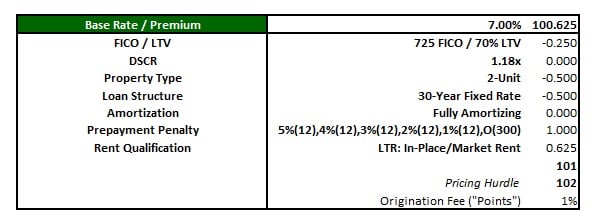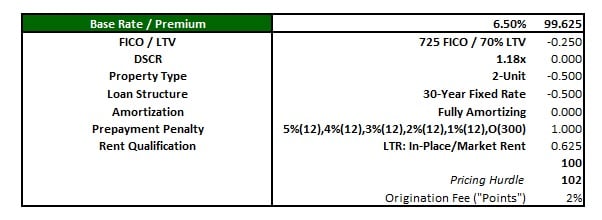As interest rates for rental properties finally start to fall after a couple of years of painful heights, many real estate investors are renewing their interest in interest rates again. With lower rates, especially on the popular DSCR loan product that allows qualification primarily based on the DSCR ratio, a comparison of rents and expenses (including interest expense), instead of the DTI ratio based on personal income, rental property purchases financed through these loans are starting to look very attractive again.
We’ve covered DSCR loans here on BiggerPockets, including a guide on how interest rates and fees are primarily determined by three key metrics: LTV ratio, DSCR ratio, and credit score. We’ve also put out an advanced strategy guide that shows how additional secondary factors also help determine your rate—such as prepayment penalties, fixed vs. ARM structure, and rent qualification type (i.e., LTR vs. STR, etc.).
However, we’ll go further and show you exactly how these factors are utilized to get that exact interest rate number you are quoted, pulling back the curtain on how DSCR lenders and mortgage brokers calculate the rate and points you see on your DSCR quotes.
Rate Sheets and Scenario Tools: The Calculator Built for Brokers and Lenders
Despite often appearing complex and sometimes esoteric, the tools utilized to create your rate are not much different than a semi-basic calculator tool and involve pretty straightforward math. Lenders will typically start every day with what’s called a “rate sheet,” which shows a range of interest rates from the lender’s minimum rate and maximum rate.
Each interest rate—typically offered in 12.5-basis point increments, or an eighth of a percent—has a corresponding “premium” number, typically around 100. These are called the base rates and serve as the starting point for calculating the interest rate on a mortgage loan.
In addition to these base rates, the rate sheets will feature what are called loan-level price adjustments (LLPAs) that move the premium number up and down based on if they indicate a higher-risk loan (moves the premium down) or a lower-risk loan (moves the premium up). The base rates are typically based on prevailing market rates, as described in this article (macro factors), while LLPAs are based on the individual deal (for DSCR loans, primarily property factors, but also based on the borrower’s credit profile too), or micro factors.
DSCR lenders will offer lower rates for loans that have a higher risk of default and are, therefore, more risky. These are usually intuitive—such as loans with higher LTVs (less difference between the value of the mortgaged property and loan amount) and lower DSCR ratios (less cash flow earned from the property) assessed as higher risk. Conversely, loans that have borrowers with higher credit scores, for example, are considered to have a lower risk of default, and borrowers will enjoy lower interest rates due to their personal creditworthiness.
Starting with a base interest rate and premium, DSCR lenders will typically input all the relevant pricing factors of the loan with their relevant adjustments (LLPAs) that add or subtract to the premium number. Then, once all the factors have been input, the lender will “solve” for the rate that produces a premium number of 100 (or a target premium number such as 102 or 103). Thus, the rate is created.
Buckets
One note before diving in: DSCR lenders will typically use mini-ranges for different metrics, sometimes called buckets, when determining factors instead of specific, exacting numbers. For example, the rate sheets used by lenders will almost certainly have LLPAs based on buckets for different inputs such as pricing for credit scores between 700 and 719, scores between 720 and 739, etc., rather than individual adjustments for specific scores.
So, for example, a qualifying FICO score of 705 and 709 would have the same adjustment, and the borrower could only secure a higher rate by improving the score to 720 or above to reach the next bucket.
Primary LLPAs—the Matrix
While many investors are likely familiar with the “big three” factors for determining DSCR interest rates (LTV, DSCR, and credit score), when it comes to calculating the rate, the majority of DSCR direct lenders will use a matrix featuring LTV and credit score as the top most influential factors (ironically, not featuring the DSCR ratio, the namesake of the loan type).
DSCR lenders will utilize what is typically called a pricing matrix as the first LLPA that adjusts the base rate and premium. It is a simple two-way matrix plotting rows and columns, where each combination of credit score bucket and LTV bucket creates the first LLPA, which is often fairly significant.
Additionally, some combinations of credit score and LTV will not be eligible due to the perceived risk. For example, as shown in an example FICO/LTV matrix, a lender may lend up to 80% LTVs, but only borrowers with a 720 or higher qualifying credit score would be eligible.

As you can see in the sample matrix, maximizing leverage, especially maximizing leverage with less-than-perfect credit, will result in significantly negative LLPAs, which will have the effect in the calculations of requiring a much higher rate. You can also see how (and why) low LTV deals, especially combined with a strong credit profile, can result in extremely favorable interest rates.
It’s important to note that this type of pricing is rarely linear, meaning every increase in LTV bucket does not result in the same change in LLPA—as a jump from the 50.1%-55% LTV bucket to the 55.1%-60% LTV bucket is only a 12.5 bps negative change, while an equivalent 5% bucket increase from 70.1%-75% LTV to 75.01%-80% LTV results in a 62.5 bps negative change!
When optimizing your interest rate on a DSCR loan, the more conservative you are leverage-wise and the better you keep your credit, the happier you are likelier to be when you get your interest rate.
DSCR LLPAs
Despite not being in the primary “matrix” of most DSCR lenders, the DSCR ratio will typically have a significant effect on your rate calculation as well. Like credit score and LTV, DSCR ratios will be in buckets, including for DSCR ratios below 1.00x!
Most DSCR lenders will have minimums of 1.00x and surprisingly treat properties not too differently when it comes to positive DSCRs, i.e., less-than-expected differences between a property with a 1.45x DSCR ratio and a 1.15x DSCR ratio, for example. Some DSCR lenders will even lend on properties with DSCR ratios under 1.00x, or even under 0.75x (sometimes called no ratio DSCR loans).
At first glance, this may seem shocking. However, there are some scenarios where DSCR loans on properties with less than 1.00x DSCR ratios make sense. But despite the surprising no ratio DSCR loan option, LLPAs for these situations are pretty harsh, and typically limited to the lower LTV buckets. A sample DSCR LLPA matrix illustrates how these can affect pricing calculations.

Loan Size LLPAs
After the LTV, credit score (FICO) and DSCR ratio are input, and the resulting major adjustments are computed. The DSCR lender will then start inputting secondary LLPAs that, while typically not as meaningful as the main three pricing drivers, will further adjust the associated premium favorably (addition) or negatively (subtraction).
Loan size is generally an LLPA for DSCR loans. Like the famous Goldilocks and the Three Bears fable, the ideal loan size for DSCR lenders is typically between the extremes—not too big and not too small.
Why? Loan sizes too large, typically once you get to the $1.5 million or above range, indicate very high-value properties and can fluctuate in value more dramatically (and thus represent higher risk), mainly because the market for the associated high-end properties is naturally smaller (fewer people can afford them if brought to market, and fewer to rent them at eye-watering rents if used as a long-term rental). As such, many DSCR lenders will assess some minor negative LLPAs for loans well into the seven figures to account for increased risk.
Additionally, when the loan size is too small, typically in the low-$100,000 range or even five figures, there is not only less margin for error (misreading the value by just a few thousand has a much larger effect), but it hurts the lender’s economics. The amount of work (and associated operating costs) to originate a $100,000 DSCR loan and a $1 million DSCR loan are often generally the same, but the lender will typically make much less money on the loan (lender economics are typically based on a percentage of the loan amount). Thus, to make smaller loans worth it economically, many DSCR lenders will assess a higher LLPA penalty for smaller loans.
The sweet-spot loan amount for most DSCR lenders is thus not too big, not too small, typically throughout the six-figure range in 2024 (~$250,000 to $1 million). These will generally not have any negative pricing adjustments and result in the best rates.
Property Type LLPAs
Another important LLPA for DSCR loans is the property type. At a high level, the risk (and thus LLPA) is derived by the liquidity and salability of the underlying property. DSCR lenders mitigate their risk primarily through the secured collateral—and the ability to foreclose and sell the property in case of default in order to be made whole or minimize losses on loans that go bad.
Similar to the example on loan size, where there is less risk for loans around $350,000 versus $3.5 million, primarily because there are so many more willing and able buyers of properties in the $500,000 value range than the $5 million range, there will be negative pricing adjustments for property types that have a smaller market of potential buyers.
As such, the market for single-family residences (SFRs) is very large (including the vast majority of owner-occupants), and vanilla single-family rentals will typically not have a negative LLPA. However, for other property types, negative pricing adjustments (and lower LTV maximum eligibility) will be typical. Since there are fewer potential buyers for condos, duplexes, or other multiunit properties, these are riskier for the lender (harder to sell in case of a foreclosure), and thus there will typically be subtractions to the pricing in the form of negative pricing LLPAs.
Loan Purpose LLPAs
Loan purpose is typically defined as either an acquisition (self-explanatory, using a DSCR loan to buy a property), rate-term refinance (a refinance transaction, where cash-out proceeds are less than $2,000 or the borrower has to bring “money to the table”), or cash-out refinances (a refinance, where the proceeds put cash in pocket, when the difference between loan amount and prior loan being paid off plus closing costs/escrows is greater than $2,000, or when the property was previously owned free and clear).
Generally, there will be negative LLPA adjustments for refinances and not acquisitions, primarily because of less certainty over value. While DSCR lenders should always be utilizing an independent third-party appraisal, a market value is more certain in an acquisition transaction (by definition, the property was just listed and sold on the market) versus a refinance transaction (appraiser estimate only). The negative LLPA will thus be assessed on refinances to account for this higher risk (less certainty on value).
Additionally, cash-out refinances generally have harsher refinances for multiple reasons. Lenders have found that psychologically, investors with less “skin in the game” after having cashed out equity are more likely to default. Furthermore, real estate fraud schemes that target lenders are most likely to be through cash-out refinance transactions, so mitigation of this elevated risk is funneled to a negative LLPA in the rate computation.
Loan Structure LLPAs
DSCR rate sheets will also typically feature multiple LLPAs based on the provisions in the mortgage loan documents. Typical loan structure adjustments that will decrease premium (and increase required rate) include choosing an “interest-only” option (actually only partially interest-only for DSCR loans, with principal payments required for the last 20 years of the term) versus a fully amortizing structure.
A lot of lenders will also typically offer what are called hybrid ARM options, where the interest rate can adjust after a certain initially fixed-rate period, such as after five or seven years, instead of choosing a 30-year fixed rate structure. Choosing a hybrid ARM is usually a positive LLPA since DSCR loans that are hybrid ARMs will normally have a price floor that restricts the interest rate on the loan to always float below the initial rate, even if market rates improve over the life of the loan.
Many investors who have utilized DSCR loans or explored the DSCR loan option versus other investment property loan types (including conventional and other non-QM loan types) have likely discovered that prepayment penalty provisions, or a percentage fee that is assessed if the borrower prepays early, are a key LLPA feature of DSCR loans. These prepayment LLPAs are positive LLPAs, whereby adding a prepayment penalty that is high in both length (how many months the penalty period is in effect) and severity (how high the fee is, expressed as a percentage of outstanding loan balance) can add significantly to the computed premium, and thus generate a lower rate.
DSCR loans with prepayment penalties high in percentage fee and length (although typically never more than 5% and five years of the 30-year term) are often the best fit for investors with a long time horizon and no plans to sell in the near term, as these DSCR rates can be equivalent or even lower than alternative conventional loan options.
See the example prepayment penalty LLPA matrix showing the significant positive effects of prepayment penalties on the computation of DSCR loan interest rates.

Other LLPAs
These LLPAs are generally standard across almost all DSCR lenders. While adjustments and minimums and maximums will vary, generally, all DSCR lenders will feature them on their pricing calculators. DSCR lenders, unlike conventional lenders, do have differentiated guidelines and loan programs, however, and these are examples of LLPA adjustments you may encounter when getting a DSCR loan, but vary from lender to lender, or be absent on some DSCR rate sheets.
Rent qualification
DSCR lenders can range from not lending on properties utilized as short-term rentals to short-term rental-friendly lenders that use aggressive underwriting guidelines such as qualifying with tools such as AirDNA. For lenders that do lend on STRs, some will view long-term rentals as less risky and thus have positive LLPAs for LTRs and negative adjustments if the property must qualify as a short-term rental.
Investor experience
DSCR lenders will typically vary in how they treat borrowers who are buying their first investment property. Lenders that do provide DSCR loans to first-time investors will sometimes have negative LLPA adjustments to account for this risk, but it is more common for these lenders to have lower LTV or loan amount maximums than charging first timers higher rates.
Poor credit history
Significant negative events in your credit history around real estate, such as recent 30+-day delinquencies on mortgage loans, or a serious “credit event” in recent history such as a bankruptcy, foreclosure, short sale, or deed-in-lieu, raise big red flags among DSCR lenders. Recent credit problems around real estate debt obviously indicate a potentially higher likelihood of future problems.
Many DSCR lenders will still lend to borrowers with these warts on their credit history, but the LLPAs are typically very negative and significant, resulting in much higher interest rates to account for this risk. If you see a DSCR loan with an interest rate that seems well above market rates, it is likely because the borrower likely has had recent problems on their credit report related to real estate loans.
Pricing Example
The chart shows a typical example of how this all flows together and a DSCR rate quote is computed. In this case, the DSCR lender has a pricing hurdle of 102—meaning they need to earn 2% on the transaction to cover costs and operate the business.
As is illustrated, a base rate and premium of 7% and 100.625, respectively, is the starting point (these are based on general market factors), and there are a series of negative LLPA adjustments (the combination of a 725 qualifying credit score and 70% LTV ratio), positive LLPA adjustments (a 5/4/3/2/1 prepayment penalty and qualifying as a long-term rental), and neutral LLPA adjustments (no adjustment positive or negative for a 1.18x DSCR in the 1.15x-1.24x DSCR bucket and utilizing a fully amortizing structure instead of any interest-only options).

As illustrated, adding and subtracting all the LLPAs from the 100.625 starting point gets to a sum of 101, which requires a 1-point origination fee to make up the difference between the price of the loan and the required pricing premium hurdle. Therefore, for this scenario, the borrower can secure a DSCR loan with an interest rate of 7% and a 1% point paid for a closing fee.
Rate Buy-Downs
Commonly, mortgage lenders will allow borrowers to buy down an interest rate, an option in which the borrower can secure a lower interest rate by paying more origination fees at closing. This is what it means to “buy down an interest rate.”
The example will show what it could look like when a borrower wants to buy down their rate. Taking the same sample scenario, in this computation, an interest rate of 6.5% is quoted, which has a corresponding base premium of 99.625 instead of 100.625. With all the same LLPAs, the sum now comes to 100, requiring a 2% origination fee instead of 1%. In this example, the borrower buys down the rate 0.5% (from 7% to 6.5%) for the price of 1% of the loan amount in the form of an additional 1% closing fee.

Final Thoughts
Hopefully this helps illuminate the computation process for interest rates and closing fees for mortgage loans, particularly DSCR loans. Many rental property investments are heavily affected by the numbers—particularly the mortgage payment and interest rate—and utilizing this knowledge to tailor your investment expectations could help make the difference between winning rentals and problem properties.
Follow the author of this article, Easy Street Capital partner Robin Simon, on multiple social platforms, including X and BiggerPockets, for more insights into rates and trends in the market for DSCR loans and to stay up to date on all the current pricing of loans for rental properties.
This article is presented by Easy Street Capital

Easy Street Capital is a private real estate lender headquartered in Austin, Texas, serving real estate investors around the country. Defined by an experienced team and innovative loan programs, Easy Street Capital is the ideal financing partner for real estate investors of all experience levels and specialties. Whether an investor is fixing and flipping, financing a cash-flowing rental, or building ground-up, we have a solution to fit those needs.
Note By BiggerPockets: These are opinions written by the author and do not necessarily represent the opinions of BiggerPockets.


